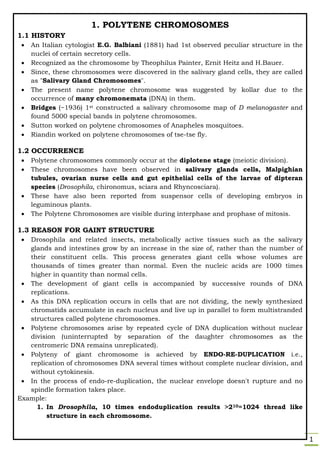
Polytene Chromosomes
- 1. 1 1. POLYTENE CHROMOSOMES 1.1 HISTORY An Italian cytologist E.G. Balbiani (1881) had 1st observed peculiar structure in the nuclei of certain secretory cells. Recognized as the chromosome by Theophilus Painter, Ernit Heitz and H.Bauer. Since, these chromosomes were discovered in the salivary gland cells, they are called as "Salivary Gland Chromosomes". The present name polytene chromosome was suggested by kollar due to the occurrence of many chromonemata (DNA) in them. Bridges (~1936) 1st constructed a salivary chromosome map of D melanogaster and found 5000 special bands in polytene chromosomes. Sutton worked on polytene chromosomes of Anapheles mosquitoes. Riandin worked on polytene chromosomes of tse-tse fly. 1.2 OCCURRENCE Polytene chromosomes commonly occur at the diplotene stage (meiotic division). These chromosomes have been observed in salivary glands cells, Malpighian tubules, ovarian nurse cells and gut epithelial cells of the larvae of dipteran species (Drosophila, chironomus, sciara and Rhyncosciara). These have also been reported from suspensor cells of developing embryos in leguminous plants. The Polytene Chromosomes are visible during interphase and prophase of mitosis. 1.3 REASON FOR GAINT STRUCTURE Drosophila and related insects, metabolically active tissues such as the salivary glands and intestines grow by an increase in the size of, rather than the number of their constituent cells. This process generates giant cells whose volumes are thousands of times greater than normal. Even the nucleic acids are 1000 times higher in quantity than normal cells. The development of giant cells is accompanied by successive rounds of DNA replications. As this DNA replication occurs in cells that are not dividing, the newly synthesized chromatids accumulate in each nucleus and live up in parallel to form multistranded structures called polytene chromosomes. Polytene chromosomes arise by repeated cycle of DNA duplication without nuclear division (uninterrupted by separation of the daughter chromosomes as the centromeric DNA remains unreplicated). Polyteny of giant chromosome is achieved by ENDO-RE-DUPLICATION i.e., replication of chromosomes DNA several times without complete nuclear division, and without cytokinesis. In the process of endo-re-duplication, the nuclear envelope doesn't rupture and no spindle formation takes place. Example: 1. In Drosophila, 10 times endoduplication results >210=1024 thread like structure in each chromosome.
- 2. 2 2. In chironomus, 13-14 times endoduplication results >16,000 chromonemata. Hence, these chromosomes are enormous structures measuring hundreds of micrometers in length and several micrometers in width. Roughly ten times longer and a hundred times wider than the metaphase chromosomes of typical eukaryotic cells. The polytene chromosomes are 2000 um in length (7.5 um in somatic cells). 1.4 STRUCTURAL ORGANIZATION Polytene chromosomes consist of a large number of partially replicated chromosomes neatly stuck together in lateral array. In Drosophila, hetero-chromatinised centromere of all Chromosomes coalesces in a "CHROMOCENTRE". The Polytene Chromosomes are found in the form of 6 radiating arms from chromocentre (5 long and 1 short arm) 1. X-chromosome (longest arm) 2. 2R (II-chromosome Right arm) 3. 2L (II-chromosome Left arm)] 4. 3R (III-chromosome Right arm) 5. 3L (III-chromosome Left arm) 6. IV-chromosome (Shortest arm) Y-Chromosome is not visualized as they are completely fused with chromocenter and they are totally heterochromatin. BANDS AND INTERBANDS When these chromosomes are treated with chromosomal stains and examined under microscope, an alternating pattern of dark (bands) and light (inter-bands) pattern is seen.
- 3. 3 The alignment of morphology, in which a series of dark transverse bands (higher coiling of chromonemata) alternate with clear zone called inter-bands (low coiling). 85% of DNA - band region 15% of DNA - inter-band region Drosophila melanogaster has ~5000 bands and ~5000 interbands per genome Each band and inter-band represent a set of 1024 identical DNA sequences arranged in file. The average band contains some 80,000 base pairs of DNA enough to encode a single polypeptide chain. The bands might contain several genes (1-7 genes), which give rise to independent transcripts and are separated by introns. Band sizes vary tremendously. The different staining properties of the bands and inter-bands are highly suggestive of difference states of compaction and organization of the chromatin in these regions. The cross banding pattern of each polytene chromosome is a constant characteristic within a species and helps for chromosome mapping during cytogenetic studies. CHROMOSOMAL PUFFS /BALBIANI RINGS The bands undergo morphological and biochemical changes related to their gene activity. Activation of the genes of a band causes the compact chromatin strands to uncoil and expand outward, resulting in a chromosomal puff. Puffs consist of DNA loops that are less condensed than the DNA of bands elsewhere in the chromosome. Puffs are active sites of gene transcription As the Drosophila larva proceeds through development, each of the polytene chromosomes in salivary gland nuclei undergoes reproducible changes in puffing patterns under the control of insect steroid hormone called ecdysone. Condensation and de-condensation at puffs correlate with the enhancement of transcriptional activity at these sites. This can be shown by briefly labeling cells with a radioactive precursor of RNA (3H- Uridine) and localizing the newly made transcripts by autoradiography. Whereas a compact DNA band synthesizes very little RNA, intense labeling occurs over the largest puffs. Use of antibodies directed against various nuclear proteins can show that molecules such that molecules such as RNA polymerase, hnRNA proteins, snRNPs, and topoisomerases specially become concentrated in the puff region.
